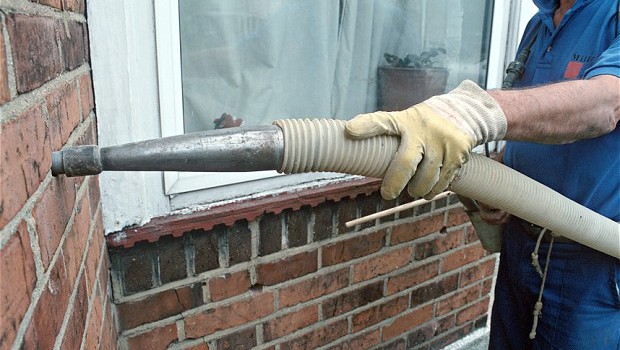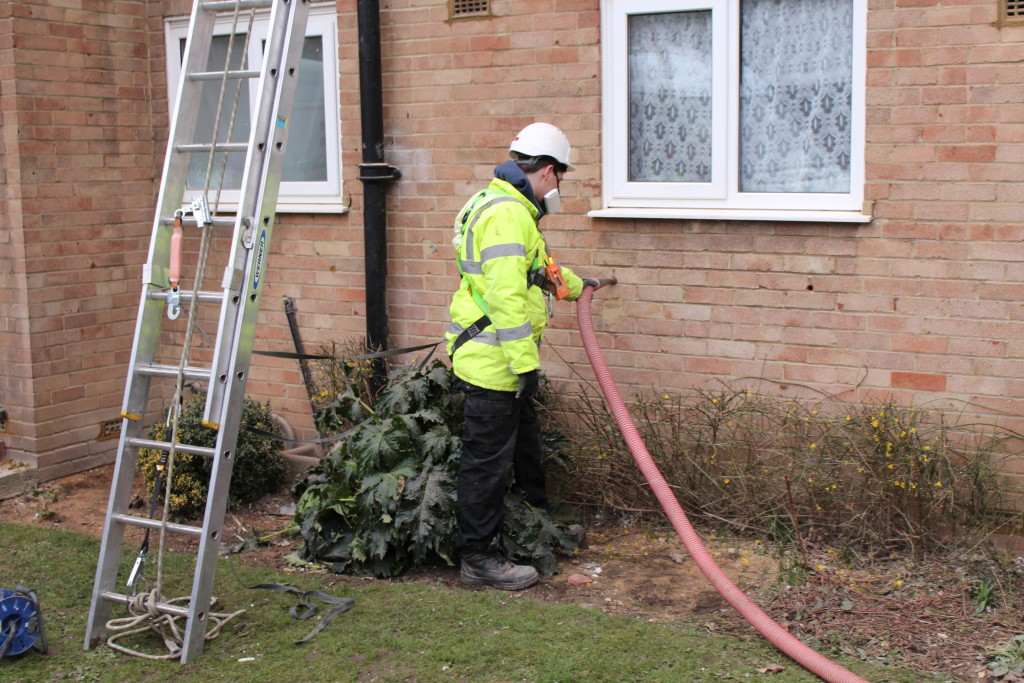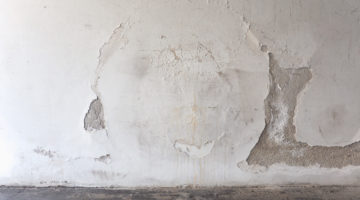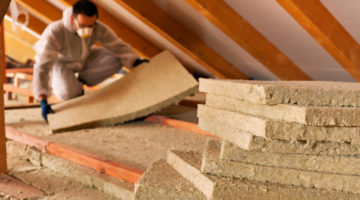
Cavity wall insulation is a great way to increase the energy efficiency of your home – and increased energy efficiency means lower energy bills.
Until relatively recently, pretty much everyone was entitled to free cavity wall insulation. However in the last few months things have changed slightly.
The reason for this is that cavity wall insulation installers are paid via a scheme known as ECO. Basically installers get paid an amount per tonne of carbon saved. This sounds a bit ridiculous, but imagine your home uses a certain amount of energy for heating – once the cavity wall insulation is installed, the amount of energy the home uses should drop because there is less heat loss. This saved energy is converted to carbon tonne savings (gas produces CO2 when it burns).
Typically, bigger houses will tend to see greater energy savings when the cavity wall insulation is installed.
- big house – 10% saving of 45,000kWh of gas is 4,500kWh
- small house – 10% saving of 17,000kWh of gas is 1,700kWh
This means the amount of funding a larger property gets will tend to be bigger than a smaller property. The same is true when a property has a very old boiler, the savings are greater in these types of home.
ECO rates have dropped
The reason that 100% free cavity wall insulation doesn’t really happen that much any more is that despite the carbon savings being the same as they have always been, the rates the cavity wall installers are paid per tonne of carbon saved have dropped considerably.
Imagine an average cavity wall job costing £1,000 on a 3-bed end of terrace property. Previously, under ECO, the installer would have been paid £1,500 to carry out the install and hence this was 100% free for the homeowner.
Now though, the installer may only be getting £500 from ECO funding, so to cover the rest of the job they need a homeowner contribution.
Homeowner contributions for cavity wall insulation
As we have hopefully explained clearly above, it is rare now for a house to get 100% funding for free cavity wall insulation. Instead, the household will have to make some contribution to get the insulation installed. How much is entirely dependent on the energy performance certificate carried out by a qualified energy assessor – this will all be calculated by the cavity wall installer who will pay for an assessor to carry out this report.

The difficulty is that the homeowner contribution can vary from house to house; so while your next door neighbour (with a bigger property and more wall to insulate) may only pay £200, you could be given a quote for £500 or more. The key though is to find a good tradesman.
Avoid cowboy cavity wall installers!
Cavity wall insulation is a fantastic energy saving solution and is installed on millions of properties across the UK, however it is does not have a 100% success rate. There are some cavity walls that should not be filled with cavity wall insulation, regardless of whether the energy savings make it an attractive proposition. Properties that are privy to driving rain, or that are located on the coast, should not have cavity wall injected into the void between the skins of brick.
>>> How to avoid cowboy tradesman <<<
Most installers would know not to install cavity wall insulation where it is not suitable. Others, often desperate for work, will not make you aware of the potential issues that may occur further down the line. Unfortunately there are lots of unscrupulous ‘cowboy’ installers out there, so the key is to avoid them and only get good qualified tradesmen.
How to ensure you are getting good quality free cavity wall insulation
The number one thing you need to do to ensure you are getting a highly rated installer is to check whether the company offering you free cavity wall insulation has the Green Deal Quality Mark and PAS2030 processes in place.

If you do want to get a decent installer you may wish to ping us through your details below:
We only work with PAS2030 installers and we seek feedback on all our installers ensuring they know what they are talking about!
Interested in learning more about the funding streams within ECO? Read on to learn more!
HHCRO, CSCO and CERO
So ECO works on the energy savings from your home. However just to complicate things, there are three different streams of ECO funding – HHCRO, CSCO and CERO.
ECO is designed to address two areas: one, to help vulnerable members of society meet the rising cost of energy prices by increasing insulation and offering more efficient sources of heat; and two, to help make more expensive measures like insulating solid and hard-to-treat wall insulation more cost effective. HHCRO addresses the first area while CSCO and CERO address the second.
Postcodes and Free Cavity Wall Insulation – CSCO / CERO
Some houses in the UK fall into CSCO / CERO postcodes – these areas are eligible for cavity wall insulation grants. The properties are situated in areas of low income, vulnerable households in rural areas or the properties are identified as hard to ‘hard to treat’ (e.g. thinner cavities).
You can use the link below to see if your property falls into one of these areas:
>> CHECK YOUR POSTCODE TO SEE IF YOU ARE ELIGIBLE! <<<
Currently, around 25% of properties fall into the postcode area, but even if you are in those locations, you may still need to make a contribution depending on the carbon savings resulting from the install of cavity wall insulation.
Qualifying for Free Cavity Insulation through Income – HHCRO
There is another avenue of ECO grant funding based on your circumstances; this is called the ‘Home Heating Cost Reduction Obligation’ (HHCRO), or Affordable Warmth. If the householder is on income support (with related top-ups), receives pension credit or tax credits, you could be eligible for free insulation. In this instance, all that is required is an Energy Performance Certificate (EPC) on the property, and you will also need to provide proof of your entitlements.
Paying for Cavity Wall Insulation
If you know for a fact that you don’t qualify for insulation through any of the means mentioned above, you can still get it installed; and after loft insulation, it offers one of the fastest returns on investment.











Dear Madam /Sir
Can you please send me more information about the Governments new free Cavity Wall insulation scheme that starts this April 2014.
D. E. Nixon
Hi David,
Please get in touch at the beginning of April and we will be able to help – the Government are yet to release any information on it, other than what is discussed above.
Kind regards
James
Hi my property was built around 1992 and the walls were insulated with cavity batts, I built an extension 5 yrs ago and when I knocked through I learnt that the cavity batts had been installed willy nilly, rendering cold spots in certain areas, although it’s impossible to calculate how much is missing, I’m wondering if I could get a top up with polyteryne balls or maybe something else, please advise. Thank you Paul.
Hi Paul,
Thanks for your comment. Without taking a closer look at your walls, it is a little difficult to give you definitive advice. Depending on the type of insulation you have, it may be possible to fill the gaps.
It is possible to extract insulation also, but it is an expensive procedure. If your budget allows, it could be worth looking at external wall insulation, which would kill two birds with one stone, adding insulation and cutting damp penetration.
Regards,
Alan
Could you recommend an installer for cavity wall installation in the EN7 6JE area.
I have had the Mark group come around and perform an initial survey and have said that I qualify as property was built in 1975 and has cavity wall contsruction.
They have said that I do need a second survey but have now failed to turn up on three occasions so would like to know if anyone else could do the installation.
This is really useful. I am desperate for cavity wall insulation but I had heard funding had run out. Will get onto this Monday morning! Time for a warmer house in time for the winter!
I live in the b23 7qp area am I entitled to free wall cavity ?
This is really useful, there is so much mis-information out there about cavity wall insulation, but this is a really concise guide to getting it for free – keep up the good work!
I wish we could get free cavity wall insulation here in France. Nuclear power too so heating is expensive 🙁
I live in a 60’s property near Clapham – sw120DG. Much appreciated if you can let me know whether I can get free cavity wall insulation for my home. Thanks!
Hi Bryony, unfortunately you don’t qualify for the free cavity wall insulation. You can obviously pay for this to be professionally installed, costing approximately £8 / m2 of wall.
This is a very useful blog thankyou. I just have a quick question if I may, is the insulation they inject the wool or is it the microbeads for this free cavity wall scheme. We have a 1940s house with a narrow cavity so I think only beads would work. Thanks – Maggie
Hi maggie – this is normally wool, since it is a cheaper material to use and the installer would get the same payment regardless of the install type – unfortunately it is driven by profit!
This is a very helpful article. thank you so much!
I am in a property that we reckon has those caviti walls do you have offer for inslations that is free.?
Hi Jermaine, have you looked at our post that shows you how to determine what type of walls you have? Have a quick read here: http://www.thegreenage.co.uk/tech/insulate-wall/
If you do have cavity wall insulation then there isn’t a problem for you to get it, as long as the permissions from the owners are in place or if it’s a flat that there is unanimous agreement. Please keep in touch and let us know if we can help.
This is very useful – we had mark group originally come out to our property but the whole process felt a bit dodgy. I shall look into the scheme again as I think we would really benefit.
Hi Lisa, please let us know how you get on. We wish you a warm and cosy house this winter!
Hi
I live in a end terrace, built 1700’s not listed, single skin brick walls. I work, my partner works and we have a 4 month old baby. Is there any way we can get free external wall cladding?
Cheers
J Sinnott
Hi Jonathan, unfortunately there is no funding that will cover the whole cost of getting solid wall insulation installed. Your best bet is to wait until the GDHIF scheme goes live again – in the summer there was a £6k grant to help cover the cost of getting this done – we are not sure what the values will be when the scheme relaunches this month – you can read more about the GDHIF scheme by clicking here
Hi Jonathan, unfortunately solid wall insulation is not free, simply due to the cost. However the Government are just about to re-launch the Green Deal Home Improvement cashback/ grant scheme (more information here: http://www.thegreenage.co.uk/green-deal-home-improvement-fund-gdhif-relaunch/) where up to £4,000 will probably be made available for homes that want to undertake this measure. You could part finance the difference yourself or take in addition the Green Deal Finance that is also on offer. Hope this helps.
Hi
I have a property that was extended some time ago by the previous owners. The original part of the house has cavity wall insulation but the extension doesn’t. Is funding (or part funding) available for extensions?
Thanks
Hi Sarah, you will need have at least 50% or more of the external walls that are not insulated to qualify for free funding. If the extension is less than 50% then you will not qualify under the ECO scheme. Hope this helps.
Our company go and install both cavity and loft insulation. With cavity insulation this is less relevant, but with loft insulation if you take out any of your existing insulation in the loft then you will get it 100% free. If the assessor finds loft insulation in the roof (even if there is only 5cm) they probably won’t be able to give you free insulation. The best way to guarantee you get it free is remove the scraggy existing insulation and then they will lay 300mm of brand new insulation in its place!
very helpful tips for cavity wall insulation thanks for posting
I have heard horror stories about cavity wall insulation causing problems. I have also heard that beads are much better than wool in this regard? I also do not hear of installers fixing the problems; are they not obliged to do so? I have a Victorian semi.
Hi Pete,
With a Victorian property I would expect it to be solid wall – so cavity wall insulation won’t work in your case (look at the brick wall and you will see half bricks – this will signify a solid brick wall).
I got cavity wall done two years ago but now rising damp has appeared under my windows, and the company who I have contacted several times, will not help..Any advice would be appreciated
Finlay,
In the first instance, you can try contacting CIGA, who are supposed to cover you in this instance. Unfortunately their track record isn’t exactly stellar. You might end up having to pay for the insulation to be removed – this is going to be a couple of thousand pounds for the typical home.
I recently had a door-to-door surveyor from SURVEYUK offer me free cavity wall insulation from Thermabead following a survey and successful Energy Performance Certificate. This was ostensibly through the Green Deal. I arranged to have a survey next week but am now feeling unsure about the whole thing. Are they cowboys? Am I likely to end up with a bodged job? I have searched online for SURVEYUK but their website is unavailable due to work, and I have looked at Thermabead’s website which appeared accredited but their registered address does not match that on my paperwork! Can you advise me please.
I have a new extension can I get free loft and between floors insulated for free
Hi Graham, unfortunately you cant get free insulation on a new structure, e.g. extensions, new loft rooms. The improvements have to be priced into the contract by your builder and have to be installed to building regs in relation to thermal properties. Subsidies on insulation are only applicable to retrofit projects.
we have recently moved home our new home has under 100mm of loft insulation and no wall insulation iam also unsure of the wall construction whether it is solid block or cavity would I be able to get free insulation in these areas?
Hi Rob, there are companies out there that offer both loft and cavity wall insulation for free under the ECO scheme, however the amount of funding available for these has dropped so it might be partial contribution. If it is solid wall insulation you require, the ECO funding will not cover the install cost, but may help slightly towards the final bill (about 10% would be covered).
I have been approached by a ‘Room in a Roof’ scheme to get loft insulation. They’ve done an EPC survey, and have told me who will be carrying out the work. This company has an address and company number, but no phone listed online and seem to have been running for only 2 years. How do I know if they are genuine or just cowboys?! Is there a list of approved companies who can carry out this work as part of the ECO2 scheme? Any advise would be much appreciated.
My house got a cavity insulation using UFOAM PLUS, done in July 1978 with 30 years of guarantee which has expired in 2008 and would like to know whether do I need to do this cavity insulation once again or is still valid.
If the cavity wall insulation is still working Prateek, then no – keep it as is. With this type of foam, it tends to disintegrate / shrink over time, so the insulation which once filled the whole of the cavity tends to slip down the wall, meaning you get cold spots. If this is the case the removal is recommended and new insulation should be installed. The process is relatively easy provided you find a decent removal company – give Extraction4homes a try if you do want it removed.
My house gets freezing in the winter. I need free cavity wall insulation. Can you email the details please.
Hi Mr Teal, there are now grants available for free cavity wall insulation – if you can provide us with a few details then we can sort this out for you – i.e. location, number etc. The email to send the information to is mailbox@thegreenage.co.uk and just put free cavity wall insulation in the email title.
Will a grant based scheme for free cavity wall insulation allow me choice of materials. I have seen this block fire in west london and i would like a fire retardant material. Do you think I can get sheep wool insulation for free? I’ve heard its the best for fire risl
Hi Adam, I think it is highly unlikely that the installer offering free cavity wall insulation will give you a choice in the material they inject into the cavity. The truth is that their is a significant price difference between the different insulation materials, so on the off chance you were given a choice it is likely you would be asked to pay the difference. Unfortunately sheep wool is a no go since it can be retrospectively injected into the cavity walls. Also the price of sheep wool insulation is relatively very high when compared to the other cavity wall insulation products, so there is zero chance you would ever get it for free!. To be fair, in terms of fire risk, since the cavity is between two skins of brick fire risk is almost zero percent, however cavity wall wool insulation is classed ‘Class A1’ in terms of its fire risk and A1 is essentially non combustable.
Had mineral wool installed by Mark Group a few years ago. Now really worried having read the Daily Mail, Geoff Howells story. Not sure if I am overreacting. We had a free boiler installed as well as the free cavity wall insulation. Are there still generous grants for us to get all this for free? I am looking to have the mineral wool replaced by polystyrene beads, but want to make sure what you offer is absolutely free. The boiler is ok for one for year. We will be looking to have this replaced next year.
Recently moved into a Bungalow built in the 80’s .It was suggested that it would benefit from extra insulation.My daughter who is part owner of the property and lives with us is in receipt of ESA as she is undergoing cancer treatment.Would we qualify for free insulation.
I own a semi detached house which has had the down stairs walls cavities filled some years ago but not the upstairs as the firm who did the job told me that the upstairs walls had a cavity less than 55mm. I see now that Go Greena say that there is now a product that can do this . Is this true or a wind up please.
They say its micro beads not wool. i had beads before for the down stairs walls. this is what they wrote.Go Greena are now pleased to be able to offer hard to treat cavity wall insulation. Hard to treat insulation uses a special type of micro-bead. The beads are injected into the walls and can flow freely into the smallest of spaces. This means that homes that previously couldn’t have cavity wall insulation now can. The best part — as long as you meet the criteria, you can have it done for free (m
Although there are signs of cavity wall insulation having been installed i.e. injection holes. I have been able to see into the cavity and there is nothing in there,what would the reason for this and what can i do about it.
Hi Glen,
It could be that a previous resident had faulty cavity wall insulation removed. I suggest that you get in touch with your energy supplier and find out what they would require in order to prove that there is no insulation currently in there.
Many thanks,
Harriet
Hi is cavity wall installalation still eligible for a grant
Hi Jane,
You may be able to get cavity wall insulation installed under the ECO3 scheme, or possibly a local grant. Your best options are to get in touch with your energy supplier about your eligibility for ECO, and give your local council a call.
I would like you to suggest a reputable cavity insulator for cw2 5js
Can you please contact me re funding/ Grant’s available.